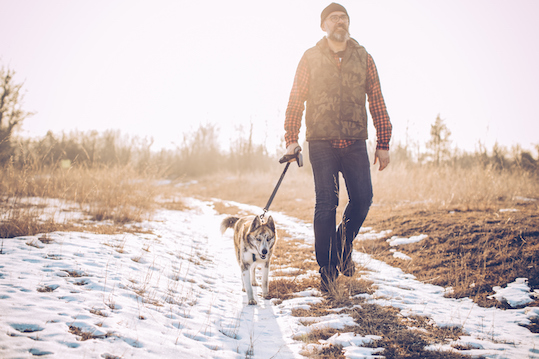Staying indoors when it’s cold can be hard on your dog. They require stimulation and time outside to stay physically and mentally healthy. Kayla Noel, of the Sage Creek Animal Hospital, reminds us not all dogs are the same, though.
“Different breeds are made for different types of weather. An Alaskan Malamute vs a Chihuahua will fair differently in the cold weather, know your breed and their needs.”
Despite the amount of outdoor time varying by breed, the common denominator amongst all dogs is a love for physical activity, and moreover, the outdoors.
Outdoors
Despite the cold temperatures, and the perceived lack of sweat and water loss in these conditions, your dog needs to stay hydrated.
“Water intake in the winter is just as important as during the summer. Encouraging your dog to drink more water can be a challenge, so keeping water clean and fresh available to them is important,” says Noel.
Morning Walk
Going for a morning walk is a win-win for you and your dog. Getting cardiovascular exercise in the morning gets your metabolism going and your heart pumping, and offers your dog a chance to get outside. This will keep your dog trim while helping them maintain a schedule. Dogs crave routine and morning walks are a great place to start! If you decide to take them out, make sure to let them stop and sniff. It’s their way of enjoying the outdoors and interacting with their surroundings.
Interval Training
Similar to a morning walk, but meant to burn calories and keep your heart-rate up, interval training is another great exercise you can share with your dog. Example: One minute walk, 20 second jog, one minute walk, 20 second side shuffle, one minute walk 20 second of running backwards. Repeat these exercises and you have a great workout for both of you!
Nose Work
Dogs have a strong sense of smell and taking the time to set up some sniffing exercises can generate lots of fun for them. If you’re interested in doing so, you can do this in your yard, while out for a walk, or at the park. Take some treats, a little bit of meat, and some other fragrant items your dog will find attractive and set them in hiding spots in the snow. Once you’re ready, set your dog loose and let them find their treats with their sense of smell.
Indoors
There is such thing as too cold. If your dog has shorter hair, or is older and has joint pain, perhaps you might be better to stay inside.
“If the weather is too cold stay indoors and play games that will challenge your pet mentally, this can be even more exhausting than physical exercise,” says Noel.
Agility Course
When the temperature is just too cold to go outside, much like we see in Manitoba with wind-chill reaching -40 degrees Celsius, sometimes the best choice is to set up an indoor agility course. For homes with unfinished basements or larger rec rooms, this is especially easy to prepare.
Using household items such as mops, brooms, chairs, desks, hoops, and anything else without any sharp edges, you can set up a great obstacle course for your pup. Treats are a great way to guide them through the course and coach them through each obstacle. Once they have it down, they’ll love the stimulation. If you have kids living at home, get them involved in building the course. This is a great activity for the whole family (dog included).
Treadmill
The treadmill is another great activity for your pup to stay active on those especially cold days. Some dogs naturally take to the treadmill, making it easy to keep an eye on them if you’re working out inside or busy with other things. It’s a great way for them to burn off some of their excess energy without having to go into the frigid cold.
Larger Breeds
Certain activities that require more size and strength are more conducive to larger breeds. Medium to large dogs require more exercise due to the energy their bodies create, so these activities can be great for their overall health. These dogs are ideal for some of winter’s most unique sports.
Kicksledding
Winter breeds, such as huskies and malamutes, make great mushing dogs. Mushing dogs are typically used to pull sleds across winter terrain. The classic image of a team of huskies pulling a sled is not always the most common application. A single strong dog can easily pull one person a on a kicksled if harnessed properly and given the right amount of lead. If you own a strong young dog with lots of excess energy, kicksledding may be the right activity for you. For more information on kicksledding in Manitoba, visit Snow Motion.
Skijoring
Similar to the concept of mushing, skijoring is an activity with Nordic origins where larger dogs, again, typically the winter breeds, pull individuals wearing skis. When properly set up, skijoring can make for an incredible bonding activity for you and your dog in the winter time. Imagine zipping around the trails with your pup on a pair of skis. Find out more about skijoring in Manitoba by visiting Snow Motion.
Safety
Safety outdoors should be top of mind when outside with your pup. There’s more than just the cold that can pose a risk.
“Ingestion of antifreeze can cause kidney stones and failure. Be cautious around metal objects, and moist paw pads, noses or tongues may stick to them. Refrain from allowing your pet to eat snow as it may be contaminated with chemicals, salt, car oil, etc. Watch your step for slippery ice. If you need to use an ice melting product, make sure to purchase one that is pet friendly. There are some on the market that are poisonous to pets or can burn their paws.”
The Sage Creek Animal Hospital is located at 102-50 Sage Creek Boulevard, inside the Village Centre. They handle all different breeds of dogs (and cats) living in the community and are open Monday to Saturday.
Healthy Accessories
There are numerous products available to help keep your pooch healthy through the winter. Raesha, from the Sage Creek Pet Valu, says there are a handful of items especially popular with dog owners.
“Boots are probably the number one winter item we sell. There are all sorts of kinds of boots available, ranging in size, thickness, and general design. Some boots are designed for your dog to quickly run outside to go to the bathroom, while others are designed for long walks, and some for hiking.”
“Our second most popular winter item would be winter jackets. Lots of small dogs are seen wearing coats in the winter, but many don’t realize big dogs get cold, too. It can be surprising, but even a larger long-haired dog can benefit from wearing a coat on the really cold days.”
Joint and skin care are two other important elements to keeping your dog healthy and comfortable in the winter. With the cold air their skin can become dry and create dandruff. Their joints can also become sore depending on their age and breed.
“Skin and joint care supplements are amongst our most popular. There are lots of different options for your dog, and we recommend coming down to find out what would best suit your pooch.”
The Sage Creek Pet Valu is located at 1000-50 Sage Creek Boulevard.

